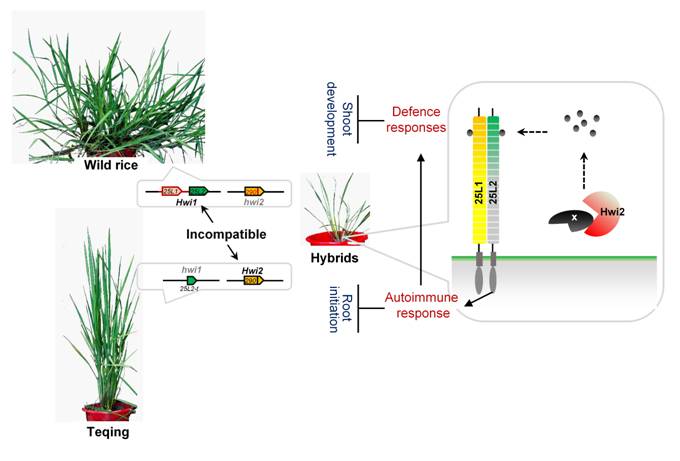New Study Identifies the Genetic and Molecular Mechanisms of the Hybrid Weakness in Interspecific Hybrids of Rice
How species become species is one of the most fascinating enigmas in nature. Reproductive isolation, such as hybrid weakness, which may be caused by genetic incompatibility after fertilization, is considered to play a vital role in this process. However, our understanding of the underlying molecular mechanisms of speciation is limited. Recently, researchers from Chinese Academy of Sciences reported a two-locus/three-gene system causes the interspecific hybrid weakness in rice.
Hybrid heterosis is wildly utilized for crop breeding. However, the hybrids, especially the ones derived from different species, may not always be preferable than the parents. The inferior performance of hybrids is defined as hybrid weakness, which always shows dwarfism, poor development and most probably, premature death that may hinder the genetic exchange. Elucidation of the underlying mechanisms of hybrid weakness will benefit for crop improvement and for increasing our understandings of speciation.
Researchers led by Dr. Hong-Xuan Lin from the Institute of Plant Physiology and Ecology, Shanghai Institutes for Biological Sciences isolated the first causal genes of hybrid weakness in monocots. They identified that two incompatible dominant loci (Hwi1 and Hwi2) involving three genes determine the high temperature-dependent expression of hybrid weakness in interspecific hybrids of rice. Hwi1 comprises two indispensable wild rice (Oryza rufipogon)-specific leucine-rich repeat receptor-like kinase (LRR-RLK) genes, 25L1 and 25L2, for inducing hybrid weakness. Hwi2, a rare allele that is predominantly distributed in indica rice (Oryza sativa), encodes a secreted putative subtilisin-like protease. Functional analysis indicated that pyramiding of Hwi1 and Hwi2 activates the autoimmune response, possibly through the ligand-receptor signal transduction, in the basal nodes of hybrids, interrupting root formation and then impairing shoot growth. These findings bring new insights into our understanding of reproductive isolation and may benefit rice breeding to maximally utilize invaluable genes from wild rice.
This work entitled “A two-locus interaction causes interspecific hybrid weakness in rice” (http://www.nature.com/ncomms/2014/140221/ncomms4357/full/ncomms4357.html) has been published in Nature Communications on Feb 21. This research was supported by grants from the National Natural Science Foundation of China, the Ministry of Science and Technology of China and the Chinese Academy of Sciences.
Figure legend. The genetic and molecular model of the expression of hybrid weakness in interspecific hybrids of rice
The Hwi1 locus comprising 25L1 and 25L2 from common wild rice is incompatible with the Hwi2 allele from Teqing. The LRR-RLKs encoded by Hwi1 possibly perceive certain molecules processed by Hwi2 to constitutively activate the autoimmune and hence, suppress the growth of hybrids. (Image by Dr. Hong-Xuan Lin's group)
